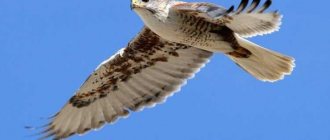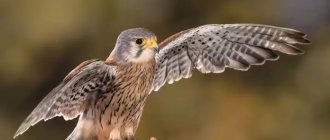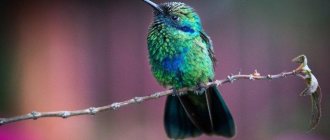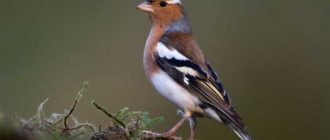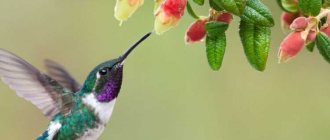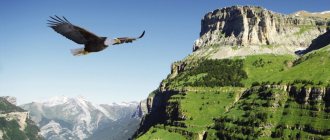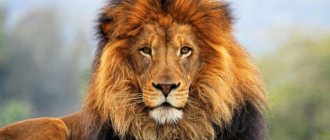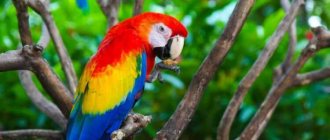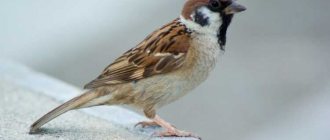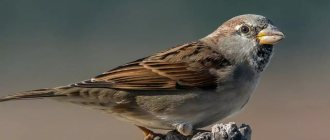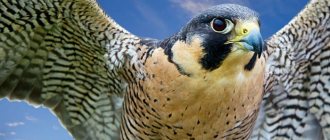- Wild animals
- >>
- Birds
Falcon is a feathered predator of the falcon family.
They are very common in the modern animal world and have a huge number of varieties. Since time immemorial, their behavior and habits have been studied quite well by humans, which has made it possible to use these birds of prey for hunting game. Falconry is still very popular to this day, not only as a form of fishing, but also as part of the culture of many nationalities, and as sporting entertainment. The falcon is a beautiful and noble bird, rightfully considered the fastest animal on Earth. When hunting, falcons are able to reach flight speeds of more than 320 km/h.
Origin of the species and description
Photo: Sokol
According to scientific research, falcons are a relatively young bird species. The age of their existence in the wild nature of our planet, including distant ancestors, is about 10 million years.
The habitat of falcons is very wide. Historically, the bird was often close to humans, easily tamed and used for hunting. The earliest mentions of domesticated pets date back to the 8th century BC and are geographically associated with the territories of modern Iraq.
Video: Falcon
The ancient Egyptians especially revered the falcon, giving its features to their gods. In Slavic mythology, the falcon was associated with courage and bravery, and even falcon plumage was considered to bring good luck. This noble, dexterous and strong bird often helped a person to hunt and survive, so its fate was inextricably linked with its owner, believing that selling or taking away a falcon was the same as depriving its owner of his soul and strength.
Falcons are natural hunters. They are swift in flight, have extremely keen eyesight, and are strong and resilient. In addition, research by ornithologists has proven that falcons are one of the most highly developed representatives of birds. All these unique qualities have long attracted people seeking to make up for their own natural deficiencies.
However, falcons lack the instinct to obey the leader. Falconry is a partnership in which the winged predator has the ultimate privilege - freedom. He hunts primarily for himself, but over time, having learned to trust his master, he accepts conditions under which prey is replaced by reward.
The classification of falcons in the wild is as follows:
- brown falcon;
- evening falcon;
- pygmy falcon;
- red-footed pygmy falcon;
- short-tailed falcon;
- small falcon;
- Mexican falcon;
- southern Mexican falcon;
- laughing falcon;
- Mediterranean falcon.
Interesting fact: Each type of falcon is created by nature to control the state of populations of certain species of birds and animals.
Role in the ecosystem
As predators, falcons influence populations of their prey on a local scale. They are also hosts for feather lice. Black caracaras have a mutualistic (mutually beneficial) relationship with tapirs.
Falcons have served people for 2,000 years. Falconry continues to be popular today, with up to 20,000 people practicing it around the world. In addition, falcons control the population of certain pests.
Photo: Cronkite News
On the other hand, falcons sometimes attack livestock, poultry, pigeons and native wild birds, leading to conflict with humans.
Appearance and features
Photo: Bird falcon
The falcon is primarily a predator, and its powerful wings, strong muscles and strong, sharp beak make it a successful hunter. The bird's sickle-shaped wingspan reaches 120 centimeters, which, coupled with well-developed trunk muscles, creates excellent flight characteristics. Falcon wings are also the sharpest, if you compare their shape with the wings of other feathered predators - eagles, hawks, golden eagles. This feature determines the falcon’s ability to shoot down prey in flight.
The falcon's beak is a perfect mechanism for catching and butchering game. Short and hook-shaped, it has a sharp tooth at the top and meets the lower jaw. The mandible is equipped with cutting teeth that fit into the recesses of the mandible when closed. This structure allows the bird to easily break the spine and small bones of its prey.
The falcon's head is quite large and rounded, with characteristic dark “whiskers” located on the sides, by which the falcon can be unmistakably distinguished from other birds of prey. The falcon's body is slightly elongated, its tail is cross-striped, quite long and has a rounded shape. This winged predator has extremely acute vision, which helps it track down prey, even at a great distance. The falcon's eyes are dark, the iris is framed by an unfeathered eyelid.
Intraspecific differences in bird size are quite significant. For example, the pygmy falcon does not grow more than 24 cm in length (about 33 cm with tail) and weighs only 70 grams. And individuals of the largest, Mediterranean falcon, reach 45-50 centimeters in length and weigh about two kilograms. Females are always larger than males, but have a paler plumage color. The most common falcons are gray, red, brown or black-gray. The abdomen is variegated in color.
Western experience
In a conversation with a Moscow 24 correspondent, Sergei Burmistrov noted that the Moscow Department of Environmental Management plans to continue working to restore the peregrine falcon population. He also shared the experience of his Western colleagues, who managed to attract the attention of ordinary citizens to peregrine falcons.
“In America, if a peregrine falcon lives on the roof of your house, then cameras and camera traps are installed there, which broadcast the image online to a plasma in the foyer of the building. A very correct approach,” the expert said.
Of the capital's buildings suitable for birds to inhabit, Sergei singled out the Moscow City skyscrapers, calling them an ideal place for the peregrine falcon to live.
Where does the falcon live?
Photo: Falcon in flight
The habitat of falcons covers almost the entire globe, with the exception of the polar zones. Some of their species are born nomads. They spend their entire lives on long flights from place to place, and can be found in any corner of the world. Other falcons lead a more sedentary lifestyle, choosing steppes and semi-deserts for their nesting sites.
While young birds fly away to warmer areas for the winter, mature birds stay at home, moving closer to water bodies with the cold weather. They can easily withstand harsh winter conditions. A decrease in the amount of game and rodents suitable for food forces birds to hunt more. In the cold season, searching for prey becomes difficult, but the natural endurance of falcons helps them survive even with a meager winter diet.
Different types of falcons have chosen different countries and continents for comfortable living. The brown falcon lives in the territories of Australia and New Guinea, populations of the Mexican falcon are found in the prairies, semi-deserts and deserts of the USA, in northern Mexico and southern Canada. The birds nesting in the northern regions of the range are migratory, while in the south they are sedentary. The meadows, savannas and swamps of the United States are favored by the South Mexican falcon.
The Laughing Falcon nests in Central and South America from northern Argentina in the south to southern Mexico in the north. It prefers tropical forests, choosing areas that are not too overgrown. The lesser falcon includes two species living in different territories. One nests in treeless areas of Southeast Asia, the other in the semi-deserts and savannas of Africa, where it is adjacent to populations of the short-tailed falcon.
The Mediterranean falcon is common in Italy and the Balkan Peninsula. Small populations of it also nest in Africa, the Arabian Peninsula and Asia Minor. This species prefers open spaces of rocky deserts and semi-deserts, settling on rocky coasts.
The open forests of the Himalayan foothills are inhabited by the pygmy red-footed falcon. Prefers areas with a lot of dry trees, near fields and meadows. This species also lives in the highlands of Nepal and Bhutan, Cambodia, Laos and Vietnam. It is found on agricultural plantations, often stays near rivers and streams, and settles both on the plains and at an altitude of about 900 m above sea level.
What does a falcon eat?
Photo: Falcon on the hunt
Thanks to its perfect hunting instinct and natural characteristics, the falcon finds food both in the air and on the ground. The “aerial” diet consists of small birds, and the “ground” menu is represented mainly by rodents and insects. Sometimes winged predators find snakes, fish and frogs for lunch. But hunting for this category of prey is of no interest to falcons, since it does not allow them to demonstrate their hunting talent in full force.
Interesting fact: The Falcon prefers live blood and fresh meat and will never eat carrion, no matter how hungry it is.
In order to get prey, the falcon uses the entire combat arsenal that nature has generously endowed it with. The hunting strategy depends on where the target is - on the ground or in the air. Thanks to its enormous flight speed and powerful and sharp wings, the falcon is able to shoot down its prey in mid-flight and finish it off completely on the ground.
If a potential meal is discovered on the ground, the falcon rushes “like a stone” at its prey, and does it so lightning fast that it is almost impossible to notice its approach. The falcon's prey has no chance of survival. With its powerful beak, it easily breaks the spine of its victim and tears it into pieces, eating it whole.
For the good functioning of the digestive system of a bird, small bones, skins and feathers must be ingested. After a few hours, the bird regurgitates the undigested remains of the meal.
Nutrition
The basis of the peregrine falcon's diet is birds. Ducks, pigeons, sparrows, thrushes, starlings are traditional falcon hunting objects. Sometimes a predator can attack small rodents if they are gaping in an open space.
There are also preferences when it comes to food. Birds do not eat the heads, legs and wings of their prey. Ornithologists note that peregrine falcon nests are always surrounded by the remains of birds, from which scientists determine what the owner of the nest eats.
Tall trees, rocks, buildings are the main places for arranging nests. It is very rare to see a peregrine falcon nest on the ground
Features of character and lifestyle
Photo: Bird falcon
Falcons are tameable birds. They show remarkable intelligence and live well in captivity, feeling affection for their owner. However, the feeling of subordination is alien to them; they are freedom-loving and independent. If the falcon is significantly limited in its flight, free space, and ability to exercise its hunting instincts, the bird will soon become ill and wither away.
By nature, falcons are silent and use their voice only to scare away enemies or to intimidate prey. And this, of course, is not singing. The melody of the sounds produced is generally alien to birds of prey. But the falcon's call makes a strong impression on everyone who can hear it. Sounding from the heavenly heights, it carries within itself something majestic, matching the appearance of the bird.
Interesting fact: Winged predators sometimes put on real shows in the sky, demonstrating to their neighbors in the sky their incredible flight capabilities, performing dizzying pirouettes, as if boasting of their own skills.
Falcon is a true master of flight. By the nature of their behavior, falcons are born nomads. Some species of these birds spend their entire lives moving. Moreover, these movements do not obey any logic; rather, the birds follow in a certain direction according to the call of the soul.
When hunting prey, the falcon often uses cunning tactics. Not wanting to attack the victim on the ground, he scares him, forcing him to fly. In the air, the winged predator has no equal in strength and speed, and capturing such prey becomes a matter of technology.
Interesting fact: During the hunt, the falcon can imitate misses by playing with its prey.
In nature, falcons live on average about 16 years, and in captivity, some individuals sometimes live up to 25 years.
What does it look like
— Advertising —
Falcon flaps its wings
The scientific name Falco comes from the word "falx", which means "sickle" - the sickle shape of the wings distinguishes falcons from other species of birds. Birds' wings are long and wide, thanks to which falcons are able to rise high into the sky and soar freely. The falcon feather is hard and glossy.
Photo of a falcon close up
The body of falcons is knocked down, rounded; The chest is wide and convex. The tail is long and shaped like a wedge. The head is large; the beak is small, strongly curved down. There are sharp teeth on the beak. The eyes are large, the skin around them is bare. The paws are thick, of medium length, four-toed.
— Advertising —
Evil look of a falcon
The color of the feather is individual for each individual species. Gray and brown tones predominate in most bird species. The plumage is not monochromatic - the main color is diluted with streaks and strokes of different sizes and colors. The irises of the eyes are usually black, the paws are bright yellow, sometimes feathered.
Social structure and reproduction
Photo: Pair of falcons
As an effective predator, the falcon does not group with other relatives, preferring a pair existence. In nature, falcons are monogamous. A couple can only change if one of the partners dies. Falcons do not build nests on the ground, preferring to choose rocks, but they can also take over someone else's abandoned nest.
The mating games of falcons are distinguished by the breathtaking beauty of their flight. The speed and grace of the pair's stunts are simply incredible. Sometimes the aerial performance ends right at the ground. When choosing a male, the female sits next to him, demonstrating that she accepts his attention. The male can court the female, bringing her food in flight, while she turns over with her belly up, accepting the gift.
Falcons never build nests at close range, maintaining a distance of 2-3 km. A falcon's clutch contains from 2 to 5 eggs. Hatching lasts about a month. If the couple decides that there is not enough food in the chosen territory to feed the chicks, the birds leave the nest to create a new one in an area more comfortable for raising offspring.
Both parents take part in incubating the eggs. The hatched chicks remain under the protection of their parents for some time, learning to hunt and survive. But barely reaching adulthood, they turn into competitors in the fight for prey. Young falcons quickly become independent, leaving the nest approximately a month and a half after birth.
After a year, the chicks can have their own nest. The number of offspring depends on many factors, one of which is certainly the adequate nutrition of the female.
Natural enemies of falcons
Photo: Falcon bird of prey
In the wild, a falcon has many enemies and is forced to fight for its own existence and actively protect its offspring.
The list of bird enemies includes almost all large forest predators:
- foxes;
- martens;
- ferrets;
- eagle owls;
- owls.
These representatives of the forest fauna can hardly cope with an adult individual, but they easily destroy falcon nests, destroying their eggs and chicks. Attacks occur most often during the absence of parents, who are forced to leave the nest to hunt, obtaining food for themselves and the chicks. In the natural environment, 70-80 percent of young animals die before reaching adulthood.
For these reasons, falcons take a very responsible approach to protecting their own nesting sites, protecting them from attacks around the clock. There are stories about how falcons attacked a dog who intended to feast on chicks and drove it away, leaving it without lunch.
When protecting nests and chicks, falcons show desperate courage and dedication. Centuries-old evolution has developed in them powerful instincts to preserve their own offspring, but this same quality also leads to tragedies associated with the death of birds. Thus, the loud war cries of alarmed birds, designed to scare away the enemy, serve as a detector for detecting their nesting sites.
Lifestyle
Falcon cries
Falcons are solitary birds. They do not gather in flocks even during migrations. Birds prefer to stay in pairs and build nests far from relatives (at a distance of 2-3 kilometers).
These birds can deftly maneuver, reach incredible speeds in flight, and deal with their prey in the air with lightning speed. At the same time, on the ground the bird does not behave so quickly and confidently. The falcon's steps on a flat surface are uncertain and clumsy. In this state, the falcon often becomes a victim of foxes, weasels and martens.
Falcon hunts hare
Falcon is a master of the hunt. Chasing prey, the bird can cover up to three hundred kilometers in an hour. Birds attack victims in the air. Sometimes, when hunting an animal, a falcon deliberately scares it so that it runs: catching “lunch” at high speed is an exciting activity for a falcon. Well-fed falcons are busy with active games in the air - they arrange comic fights with their brothers, plan for hours, and perform exciting pirouettes.
The lifespan of falcons is 15-16 years. However, in the wild, not all birds survive to the age limit. In captivity, birds can live 18-20 years.
Falcon hunting
Falcon hunts in winter.
Falcons hunt in the air. Birds spend hours gliding in the sky in search of prey. Having noticed the prey, the bird rises high above it (to gain speed), and then quickly rushes vertically down towards the prey. Having reached the victim, it strikes it with force with its muscular paws. The kick can be so strong that the game dies instantly. Having killed an animal, the falcon brings it to a quiet place, where it first plucks and butchers it, and only then eats it.
Two falcons cannot divide their prey
Every day one falcon eats 200-250 grams of food. In a hungry year, the predator eats the whole prey, but if the bird does not lack food, it can only eat large muscles.
Reproduction
Photo of a
falcon Falcons are monogamous birds. Different species have their own nesting periods: southern falcons mate in the summer - from July to September; birds living in the north breed from February to March. Mating rituals are similar among all bird species. The male presents the female he likes with a gift - a twig or leaf. Ritual dances of males last 7-10 days. At this time, birds circle in the sky and constantly sing loud, ringing songs.
Falcon family
Mating of partners takes place in the sky. Sometimes you can see how birds, clinging to each other with their claws, rise high into the sky, and then suddenly rush to the ground. The diving flight lasts 5-10 seconds, then the falcons begin to smoothly rise upward again.
Chicks and falcon in the nest
Birds choose secluded, quiet places to nest. Birds nest on the tops of trees, under the eaves of buildings or in rock gorges. Some species of falcons prefer not to waste time on arranging their homes, and occupy the abandoned nests of other birds. The female lays 2-4 large, red-colored eggs at a time. The larger the bird, the more eggs it can lay. Both parents are involved in breeding offspring. While the female sits on the eggs, the male feeds. Then the parents change. The incubation period is 29-32 days.
Falcon chicks
Photo of a falcon chick.
Falcon chicks are born sighted and well-furred. The fluff is dirty white. For the first three weeks of life, parents warm and feed the chicks and protect them from birds of prey and animals. The diet of chicks includes insects, eggs of other birds, and lizards.
A falcon chick in a man's hand
After a month, the falcon chick already knows how to get its own food and defend itself from enemies. During this period, the falcon leaves the parent's nest. He does this because the parents stop seeing him as their baby and begin to treat him as a competitor for food. If the chick does not leave the nesting site in time, the adults may peck at it.
Two falcon chicks
In the first year of life, grown falcons fly to warm countries for the winter. By the age of two they reach sexual maturity - from then on, most of them stop migrating.
